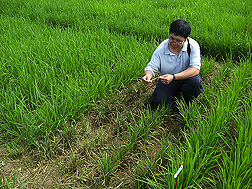This page has been archived and is being provided for reference purposes only. The page is no longer being updated, and therefore, links on the page may be invalid.
|
Read the magazine story to find out more. |
|
|
U.S. Rice Collection Proves a Genetic Treasure Chest
By Erin PeabodyJuly 12, 2006
Agricultural Research Service scientists have discovered a few good rice plants--and are taking them to the bank.
The researchers, in their hunt for rice genes to guard against the devastating rice blast pathogen Magnaporthe grisea, recently tapped the country’s most diverse collection of rice. This genebank--the U.S. Department of Agriculture’s (USDA) Rice Core Collection--contains more than 1,700 rice plant accessions from more than 100 countries.
The ARS scientists, working at the Dale Bumpers National Rice Research Center in Stuttgart, Ark., evaluated the hundreds of accessions by growing and testing each one in the laboratory and field.
Led by ARS geneticist Wengui Yan, the scientists discovered new rice genes resistant to blast. This destructive disease impacts about 30 percent of the world’s rice plants each year.
Finding new genes to counter disease, pests and other threats is central to the longevity of all crops. But rice, which helps feed more than two-thirds of the world’s population, especially benefits from continuous access to new genetic material, or germplasm.
That’s because the crop’s nemesis, rice blast, has growers and breeders engaged in a never- ending, tug-of-war battle. Farmers plant rice that’s expected to stand up to the blast-causing fungus. But in just a short period of time, the pathogen finds a new way to overcome its weary host.
The blast resistance genes the Stuttgart researchers discovered should give rice plants a needed boost. These findings are different from any resistance genes currently available to the U.S. rice industry.
The USDA Rice Core Collection is part of the ARS-coordinated National Plant Germplasm System, a cooperative effort by public and private organizations to preserve crops’ genetic diversity. This collection is referred to as “core” because it captures the essential genetic diversity contained in an even larger USDA rice collection of 18,000 accessions. Working with a smaller core collection streamlines breeders’ efforts to uncover valuable genes.
Read more about the research in the July 2006 issue of Agricultural Research magazine.
ARS is the USDA’s chief scientific research agency.

